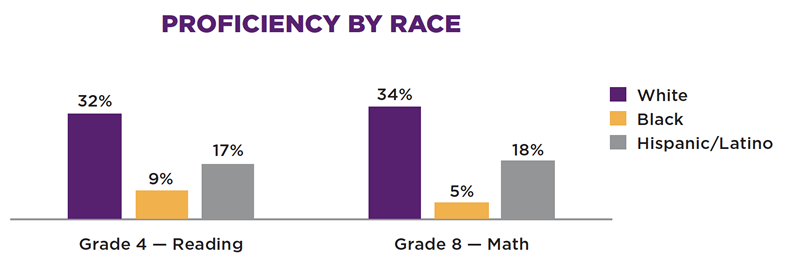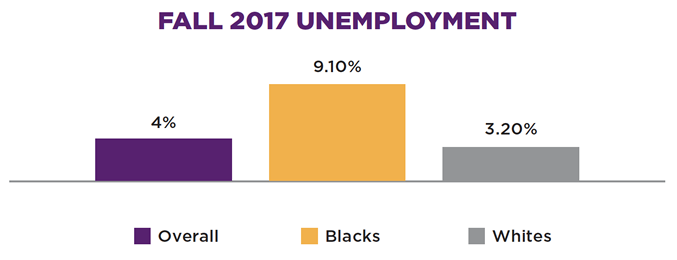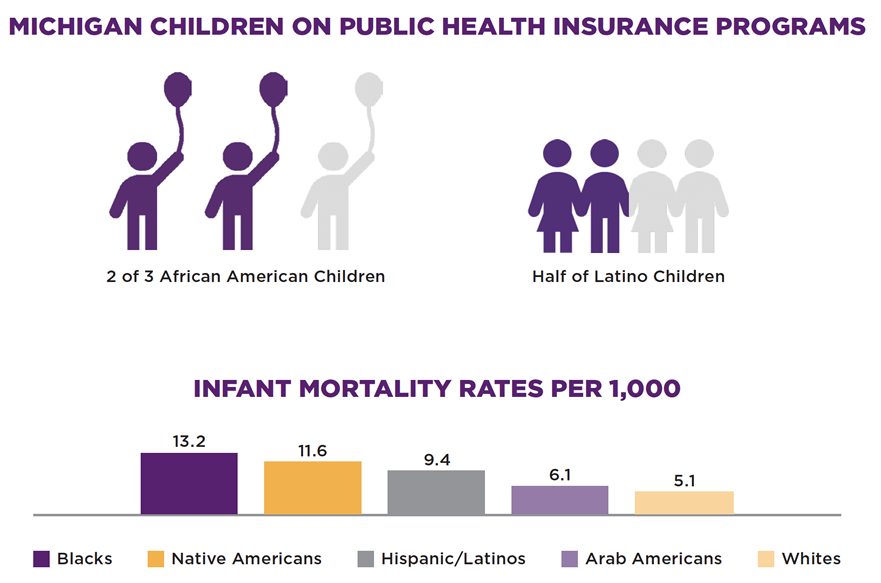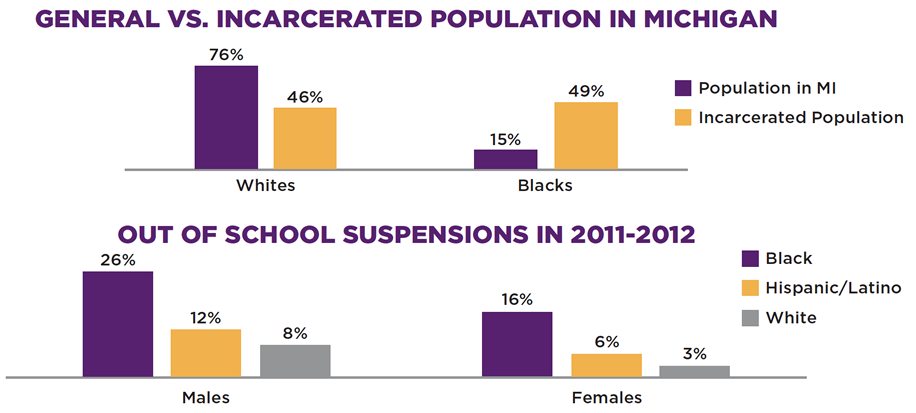INTRODUCTION
New Detroit’s (NDI’s) mission to achieve racial understanding and racial equity in Metropolitan Detroit is as significant in 2020 as it was when the organization was established more than 50 years ago. The racial equity highlights presented here serve as an “interim update” to our 2014 Metropolitan Detroit Race Equity Report (“the Scorecard”) and is the first of many reports that will be released by NDI and its partners throughout the year. The purpose of these reports is to provide timely analysis of racial equity across the region using data drawn from a variety of sources including other recent reports on race.
It is well established that in recent years, Detroit has experienced a period of significant growth and change in a number of areas. The number of new restaurants and retail establishments, for example, has increased exponentially, although this growth has largely been limited to the seven square mile area that makes up the downtown core. To date, the chief beneficiaries of this transformation have, to a great extent, been limited to relatively affluent, White residents. Efforts have been made to address issues of equity and inclusion, but given longstanding barriers to racial equity in Detroit, there remains much to be done.
These highlights lift up a range of issues concerning racial equity, beginning with a section summarizing the emerging racial equity implications of the COVID-19 virus. A summary of racial equity indicators follows the section on COVID-19, and is organized by the categories listed below:
• Education
• Housing
• Income and Wealth
• Employment and Entrepreneurship
• Health
• School Discipline and Incarceration

HOUSING
Detroit remains one of the most segregated cities in the country. Additionally, significant racial disparities remain in owning homes, residing in owner-occupied homes, and furthermore with living in middle class neighborhoods.
• Detroit is the most segregated city in the country, with more than half the Black population living in neighborhoods that are 80% Black.
• As of 2016, 77% of White families in Michigan owned their own homes, compared to 40% of Black families, 55% of Hispanic/Latino families, 56% of Native American families, and 55% of Asian American families.
• Only 47 percent of Black households, 58 percent of Other/mixed race households, 60 percent of Latino households, and 64 percent of Asian households are owner occupied compared to 80 percent of White households.
• COVID-19: Research suggests that racial residential segregation is a fundamental cause of health disparities. For example, racial residential segregation is linked with a variety of adverse health outcomes and underlying health conditions. These underlying conditions can also increase the likelihood of severe illness from COVID-19.

INCOME & WEALTH
Income and wealth shows some of the most significant racial and ethnic disparities in Detroit, with gaps showing in income, rates of working poverty, and net worth. A disproportionate amount of income disparities are attributed to employment gaps, compared to the national average.
• Detroit has the highest percentage of lower-income residents (with incomes under $25,000) and the lowest percentage of high-income residents (income greater than $150,000).
• Latinos have the highest rate of working poverty, at 9.9 percent, and Arab Americans and Blacks also have working poverty rates that are well above average (8.6 percent and 6.4 percent, respectively). Whites have the lowest rate of working poverty at about 2 percent.
• The median net worth of White households in Michigan was $91,000, compared to only $4,000 for households of color, a gap of $87,000.
• COVID-19: The median net worth of African American families is $17,600, compared with $171,000 for White families, and a White family is likely to have $10 for every $1 an African American family has. Approximately 73% of African Americans and 70% of Hispanics/Latinos, compared with 47% of Whites, report that they do not have emergency funds to cover three months of expenses, leaving them especially vulnerable to economic downturns, such as the current COVID-19 crisis.

EMPLOYMENT & ENTREPRENEURSHIP
Differences in employment are seen in wages, income gaps, and unemployment rates. Entrepreneurship rates are believed to be similar, though the success of businesses owned by people of color differ significantly on size, profitability, and early survival rates.
• African Americans consistently have higher unemployment and lower wages compared with their White counterparts. For African Americans without a high school diploma, their unemployment rate is 41 percent compared to 23 percent for Whites.
• Fall 2017 unemployment: Overall 4%, Whites – 3.2%, Blacks 9.1%
• Nationally, 34 percent of the racial income gap is due to differences in employment. In the Detroit region, the share of the gap attributable to employment is even higher, at 58 percent.
• Blacks and Hispanics/Latinos start businesses at rates similar to Whites – in fact, Blacks may be more likely to pursue entrepreneurship. However, businesses owned by people of color diverge from White-owned businesses in size, profitability, and early survival rate.
• COVID-19: 44% of African Americans and 61% of Hispanics/Latinos report that someone in their household has either lost a job or taken a pay cut due to COVID-19, compared with 38% of Whites.

HEALTH
Health disparities are seen throughout the life span, starting with infant mortality and low birthweights, extending through health outcomes including obesity rates and care practices.
• Infant mortality rates: 13.2 per 1,000 for Blacks, 11.6 for Native Americans, 9.4 for Hispanics/Latinos, and 6.1 for Arab Americans, compared to 5.1 per 1,000 for Whites.
• Obesity rates: 31% overall, Blacks at 38% and Whites 30%. Diabetes rates in MI: 14% for Blacks compared to 9% for Whites.
• Two of every three African American children–and half of Latino children–in Michigan rely on public health insurance programs.
• People of color are less likely to receive the recommended standard of care for the same conditions.
• COVID-19: Approximately 27% of African Americans, compared with 13% each of Hispanics/Latinos and Whites personally knew someone who had been hospitalized or died due to COVID-19.

SCHOOL DISCIPLINE & INCARCERATION
Prisons have a disproportionate Black population as compared to their White counterparts. Both Black males and females have higher out-of-school suspension rates than White males and females, despite evidence suggesting that they do not act out at different rates. Children of incarcerated parents have significant long term effects, which further hinders behavior, health, and educational outcomes.
• Whites make up 76% of the population in Michigan and in 2014 made up 46% of the incarcerated population, while Blacks represent 15% of the population and 49% of the incarcerated population.
• 26% of Black male students had out-of-school suspensions in 2011-2012, compared to 12% of Hispanic/Latino males and 8% of White males.
• 16% of Black female students had out-of-school suspensions in 2011-2012 compared to 6% of Hispanic/Latino females and 3% of White females.
• Children with incarcerated parents are more likely to experience homelessness, drop out of school, develop learning disabilities, experience anxiety, stress and depression, and suffer from physical health problems, all of which hinder educational and other outcomes.
• COVID-19: African Americans comprise 12% of the adult population in the U.S., but account for 33% of the prison population—nearly triple their share of the overall population. In jails and prisons nationally, the COVID-19 infection rate is about 2 ½ times higher than in the general population. In Michigan, at Lakeland Correctional Facility, so far the only prison in Michigan to have tested all of its inmates, approximately 55% of the prisoners tested positive.
• Police violence is a leading cause of death for young men in the United States. Black men face a 1 in 1,000 chance of being killed by police over their lifetime compared to about 1 in 2,000 for men in general and about 1 in 33,000 for women – about 20 times lower than men.

NEXT STEPS
In the days ahead, New Detroit’s racial equity research will continue. Interviews will be conducted with key stakeholders to help inform the update of the Racial Equity Scorecard, and additional indicators will be identified for inclusion in the Scorecard. In the meantime, for our partners and stakeholders in this racial equity work, we can give thought to the overarching questions that we should be asking to guide the research and our collective conversation as it moves forward. For example,
• Are there opportunities for alignment across efforts that can increase awareness and build capacity to do this work effectively?
• What policy levers will have the greatest impact in addressing racial inequities?
• What are the key roles for stakeholders engaged in this effort — residents, philanthropy, community and business leaders — and what approaches, individually and collectively, show the most promise for addressing structural racism?
• What are the indicators of progress in systems and practices that should be measured and monitored?
The highlights presented here are one of many approaches that New Detroit is undertaking in our commitment to redoubling our focus on racial equity. We look forward to building on this research, sharing what we learn with community and business leaders, and to engaging the broader community in discussions that will ultimately result in measurable change.
SOURCES
American College of Physicians. Racial and Ethnic Disparities in Health Care, Updated 2010. Philadelphia: American College of Physicians; 2010: Policy Paper. (Available from American College of Physicians, 190 N. Independence Mall West, Philadelphia, PA 19106.) https://www.acponline.org/system/files/documents/advocacy/current_policy_papers/assets/racial_disparities.pdf
American Council on Education. Educational Attainment by Race and Ethnicity. https://www.equityinhighered.org/indicators/u-s-population-trends-and-educational-attainment/educational-attainment-by-race-and-ethnicity/
Benjamin Le Cook, Thomas G. McGuire and Samuel H. Zuvekas. (2009, February) Measuring Trends in Racial/Ethnic Health Care. Medical Care Research and Review. https://www.ncbi.nlm.nih.gov/pmc/articles/PMC2764787/
Centers for Disease Control and Prevention. (2020, April 22) COVID-19 in Racial and Ethnic Minority Groups. https://www.cdc.gov/coronavirus/2019-ncov/need-extra-precautions/racial-ethnic-minorities.html
Dian Schaffhauser, (2020, May 14) Poverty, Race Linked to Lack of Internet for Students. The Journal. https://thejournal.com/articles/2020/05/14/poverty-race-linked-to-lack-of-internet-for-students.aspx
Frank Edwards, Hedwig Lee, Michael Espositio, (2019, August 20). Risk of Being Killed by Police Use of Force in the United States, by Age, Race-Ethnicity and Sex. Proceedings of the National Academy of Sciences. https://www.pnas.org/content/116/34/16793
Institute of Medicine. (2003) Unequal Treatment: Confronting Racial and Ethnic Disparities in Health Care. Washington, DC: The National Academies Pres. https://doi.org/10.17226/10260
John Gramlich, (2020, May 6) Black Imprisonment Rate in the U.S. Has Fallen by a Third Since 2006. Pew Research Center. https://pewrsr.ch/2zc6PKi
Lauren Aratani, Dominic Rushe, (2020, April 28) African Americans Bear the Brunt of COVID-19’s Economic Impact. The Guardian. https://www.theguardian.com/us-news/2020/apr/28/african-americans-unemployment-covid-19-economic-impact
Mark Hugo Lopez, Lee Rainie And Abby Budiman, (2020, May 5) Financial and Health Impacts of COVID-19 Vary Widely by Race and Ethnicity. Pew Research Center. https://pewrsr.ch/2L15rwr
New Detroit. (2014). Metropolitan Detroit Race Equity Report. https://www.newdetroit.org/metropolitan-detroit-race-equity-report/
Radley Balko, (2020, May 1) Stopping COVID-19 Behind Bars was an Achievable Moral Imperative. We Failed. Washington Post. https://www.washingtonpost.com/opinions/2020/05/01/stopping-covid-19-behind-bars-was-an-achievable-moral-imperative-we-failed/
Sorenson, P. (2017, September 30) 2017 Making Change: The State Budget as a Tool for Racial and Ethnic Equity. Michigan league for Public Policy. https://mlpp.org/racial-equity-issues/report-2017-making-change-the-state-budget-as-a-tool-for-racial-and-ethnic-equity/
Southern Poverty Law Center. (2019, July 19). Weekend Read: Racism is Killing Black Americans. https://www.splcenter.org/news/2019/07/19/weekend-read-racism-killing-black-americans
William K. Kellogg Foundation and Altarum. (2018). The Business Case for Racial Equity. https://www.wkkf.org/resource-directory/resource/2018/07/business-case-for-racial-equity
Woes compounded; Race and covid-19. (2020, April 11). The Economist, 435(9189), 18(US). Retrieved from https://link-gale-com-proxy1-cl-msu-edu.proxy2.cl.msu.edu/apps/doc/A619851871/STND?u=msu_main&sid=STND&xid=5f4205dc



